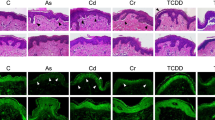Abstract
Sulfur mustard (SM) is known to induce cutaneous injury and to cause acute damage to the respiratory tract. Although skin vesication has been demonstrated on human epidermal keratinocytes in culture, no study has been carried out to analyze the effects of SM on the ultrastructural and functional activity of surface respiratory epithelial cells. To evaluate this SM toxicity, we developed an in vitro model of respiratory epithelial cells in primary culture. The study was performed on surface epithelial cells from rabbit trachea cultured according to the explant-outgrowth technique. The functional activity of the cultures was evaluated by measuring the ciliary beating frequency (CBF) of the ciliated cells with a videomicroscopic method. The morphological aspects of the cells were analyzed by light and electron microscopy. Addition of 0.1 mM SM directly into the culture medium produced a sudden and irreversible CBF inhibition, first observed after 2 hr on the ciliated cells of the outgrowth periphery. The arrest of the ciliary beating progressively reached the whole surface of the outgrowth and was simultaneously observed with a detachment of the outgrowth cells. It began at the outgrowth border, leading to the exfoliation of cell sheets, and then to the whole culture after 48 hr. Morphological damage was expressed by intense vacuolisation and disorganization of cytoplasmic and nuclear structures. These findings suggest that the detachment of the respiratory epithelial cells from the matrix represents a major toxic effect of 0.1 mM SM. SM dramatically affects the viability of respiratory epithelial cells in culture. Moreover, the sudden CBF inhibition is more likely due to the death of the ciliated cells than to a specific ciliotoxic effect of SM.
Similar content being viewed by others
Abbreviations
- CBF:
-
ciliary beating frequency
- HEPES:
-
N2-hydroxyethylpiperazine-N'2ethanesulfonic acid
- PBS:
-
phosphate buffer saline
- SM:
-
sulfur mustard
- TEM:
-
transmission electron microscopy
References
BAEZA-SQUIBAN, A., ROMET, S., MOREAU, A., and MARANO, F. (1991). “Progress in outgrowth culture from rabbit tracheal explants: Balance between proliferation and maintenance of differentiated state in epithelial cells.” In Vitro Cell. Dev. Biol. 27A: 453–460.
BALALI, M. (1984). “Clinical and laboratory findings in Iranian fighters with chemical gas poisoning.” Arch. Belg., Suppl.: 254–259.
BLANQUART, C., ROMET, S., BAEZA, A., GUENNOU, C., and MARANO, F. (1991). “Primary cultures of tracheal epithelial cells for the evaluation of respiratory toxicity.” Toxic. In Vitro 5: 499–502.
CHEVILLARD, M., HINNRASKY, J., ZAHM, J.M., PLOTKOWSKI, M.C., and PUCHELLE, E. (1991). “Proliferation, differentiation and ciliary beating of human respiratory ciliated cells in primary culture.” Cell Tissue Res. 264: 49–55.
CHIPMAN, J.K. (1989). “Mechanisms of cell toxicity.” Current Opinion in Cell Biology 1: 231–235.
COLARDYN, F., DEKEYSER, H., RINGIOIR, S., and DEBERSAQUES, J. (1986). “Clinical observation and therapy of injuries with vesicants.” J. Tox. Clin. Exp. 6: 237–246.
DANNENBERG, A.M., PULA, P.J., LIU, L.H., HARADA, S., TANAKA, F., VOGT, R.F., KAJIKI, A., and HIGUCHI, K. (1985). “Inflammatory mediators and modulators released in organ culture from rabbit skin lesions produced in vivo by sulfur mustard.” Am. J. Pathol. 121: 15–27.
DUCKETT, K.E., SCHILLER, S.L., GIRARD, P.R., and KENNEDY, J.R. (1986). “The effects of gossypol on the ultrastructure and function of tracheal ciliated cells.” J. Submicrosc. Cytol. 18(1): 117–125.
FISCHER, G.L. and PLACKE, M.E. (1988). “Cell and organ culture models of respiratory toxicity.” In: Toxicology of the Lung (D.E. Gardner, J.D. Crapo, and E.J. Massaro, eds.). Raven Press, New York. pp. 285–314.
FOX, M. and SCOTT, D. (1980). “The genetic toxicity of nitrogen and sulphur mustard.” Mutat. Res. 75: 131–168.
GROSS, C.L., MEIER, H.L., PAPERMEISTER, B., BRINKLEY, F.B., and JOHNSON, J.B. (1985). “Sulfur mustard lowers nicotinamide adenine dinucleotide concentrations in human skin grafted to athymic mice.” Toxicol. Appl. Pharmacol. 81: 85–90.
KENNEDY, J.R. and RANYARD, J.R. (1983). “Morphology and quantitation of ciliated outgrowths from culture rabbit tracheal explants.” Eur. J. Cell Biol. 29: 200–208.
LEIPNER, N., DEWES, W., SCHÜLLER, H., and HELM, U. (1988). “Lungenparenchymveranderungen nach Schwefellost-vergiftung.” Fortschr. Rontgenschr. 147(2): 147.
McADAMS, A.J. (1956). “A study of mustard vesication.” J. Invest. Dermat. 26: 317–325.
MEIER, H.L., GROSS, C.L., and PAPERMEISTER, B. (1987). “2,2′-dichlorodiethyl sulfide (sulfur mustard) decreases NAD+ levels in human leukocytes.” Toxicol. Lett. 39: 109–122.
PAPERMEISTER, B., GROSS, C.L., PETRALI, J.P., and HIXSON, C.J. (1984). “Pathology produced by sulfur mustard in human skin grafts on athymic nude mice. I. Gross and light microscopic changes.” J. Toxicol.-Cut. & Ocular Toxicol. 3: 371–391.
PAPERMEISTER, B., GROSS, C.L., MEIER, H.L., PETRALI, J.P., and JOHNSON, J.B. (1985). “Molecular basis for mustard-induced vesication.” Fundament. Appl. Toxicol. 5: S134–149.
ROMET, S., DUBREUIL, A., BAEZA, A., MOREAU, A., SCHOEVAERT, D., and MARANO, F. (1990). “Respiratory tract epithelium in primary culture: Effects of ciliotoxic compounds.” Toxicol. In Vitro 4: 399–402.
SMITH, W.J., CLARK, L., GROSS, C.L. CHAN, P.C., and MEIER, H.L. (1990). “The use of human epidermal keratinocytes in culture as a model for studying the biochemical mechanisms of sulfur mustard toxicity.” Cell Biol. Toxicol. 6(3): 285–291.
SOHRABPOUR, H. (1984). “Clinical manifestations of chemical agents on Iranian combatants during Iran-Iraq conflict.” Arch. Belg., Suppl.: 291–297.
VOGT, F.R., DANNENBERG, A.M., SCHOFIELD, B.H., HYNES, N.A., and PAPERMEISTER, B. (1984). “Pathogenesis of skin lesions caused by sulfur mustard.” Fundament. Appl. Toxicol. 4: S71-S83.
WADA, S., NISHIMOTO, Y., MIYANISHI, M. KAMBE, S., and MILLER, R.W. (1968). “Mustard gas as a cause of respiratory neoplasia in man.” Lancet 1: 1161–1163.
ZAHM, J.-M., DIONISIUS, J.-P., PIERROT, D., CHEVILLARD, M., and PUCHELLE, E. (1990a). “Mesure de la fréquence de battement ciliaire sur écran video.” Innov. Tech. Biol. Med. 11(2): 118–129.
ZAHM, J.-M., PIERROT, D., HINNRASKY, J., FUCHEY, C., CHEVILLARD, M., GAILLARD, D., and PUCHELLE, E. (1990b). “Functional activity of ciliated outgrowths from cultured human nasal and tracheal epithelia.” Biorheology 27: 559–565.
Author information
Authors and Affiliations
Rights and permissions
About this article
Cite this article
Chevillard, M., Lainee, P., Robineau, P. et al. Toxic effects of sulfur mustard on respiratory epithelial cells in culture. Cell Biol Toxicol 8, 171–181 (1992). https://doi.org/10.1007/BF00260566
Received:
Accepted:
Issue Date:
DOI: https://doi.org/10.1007/BF00260566




